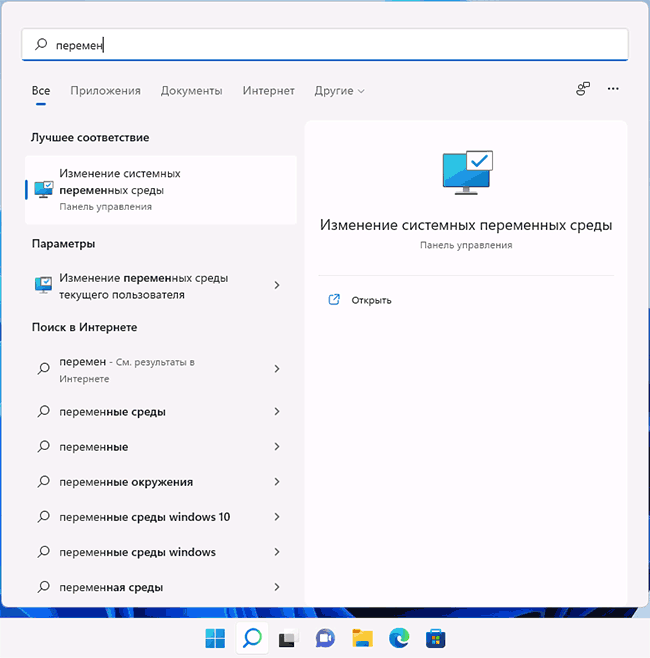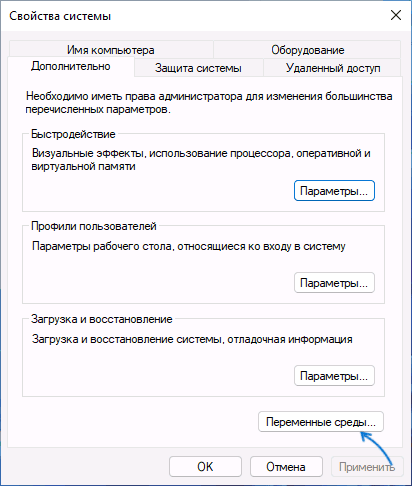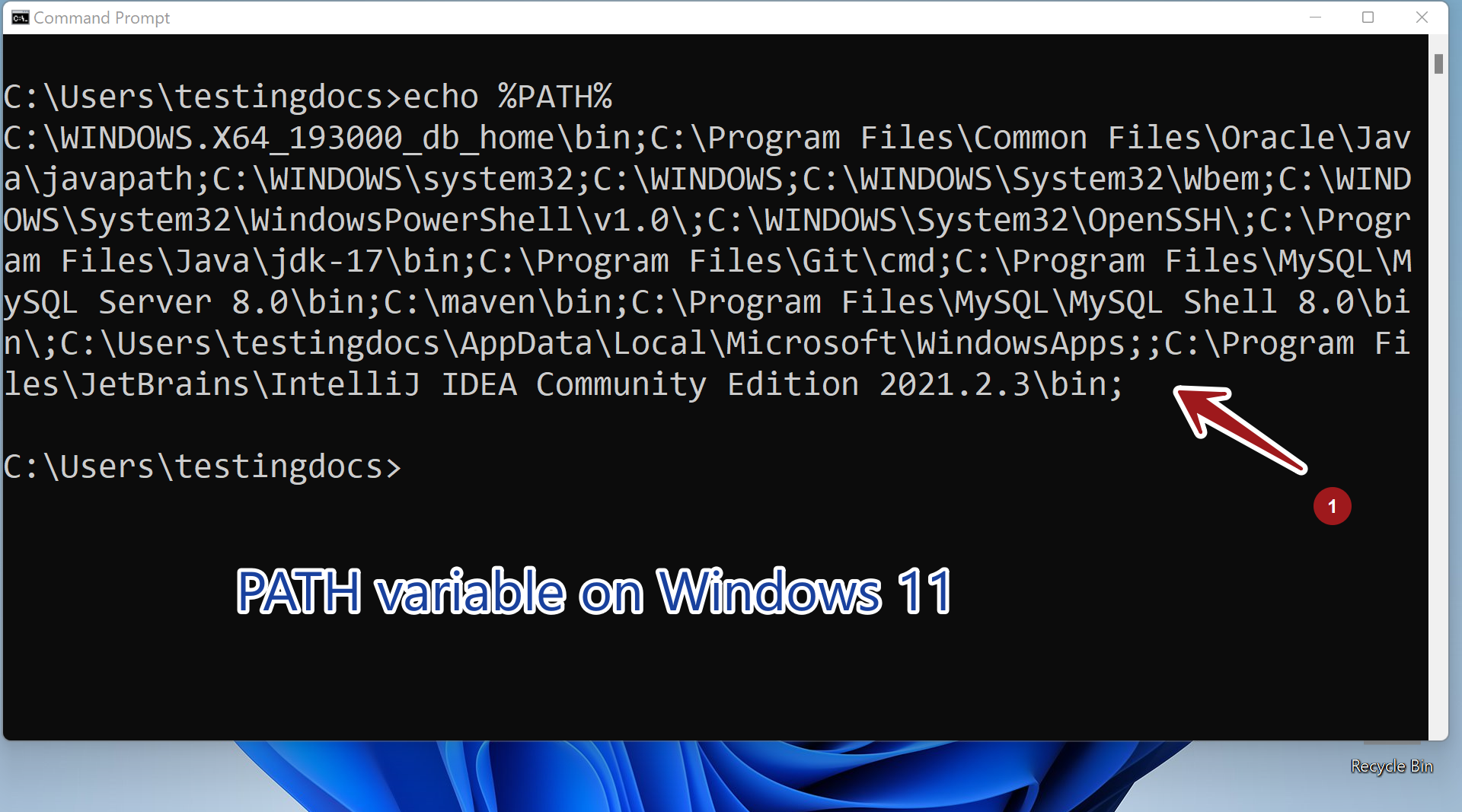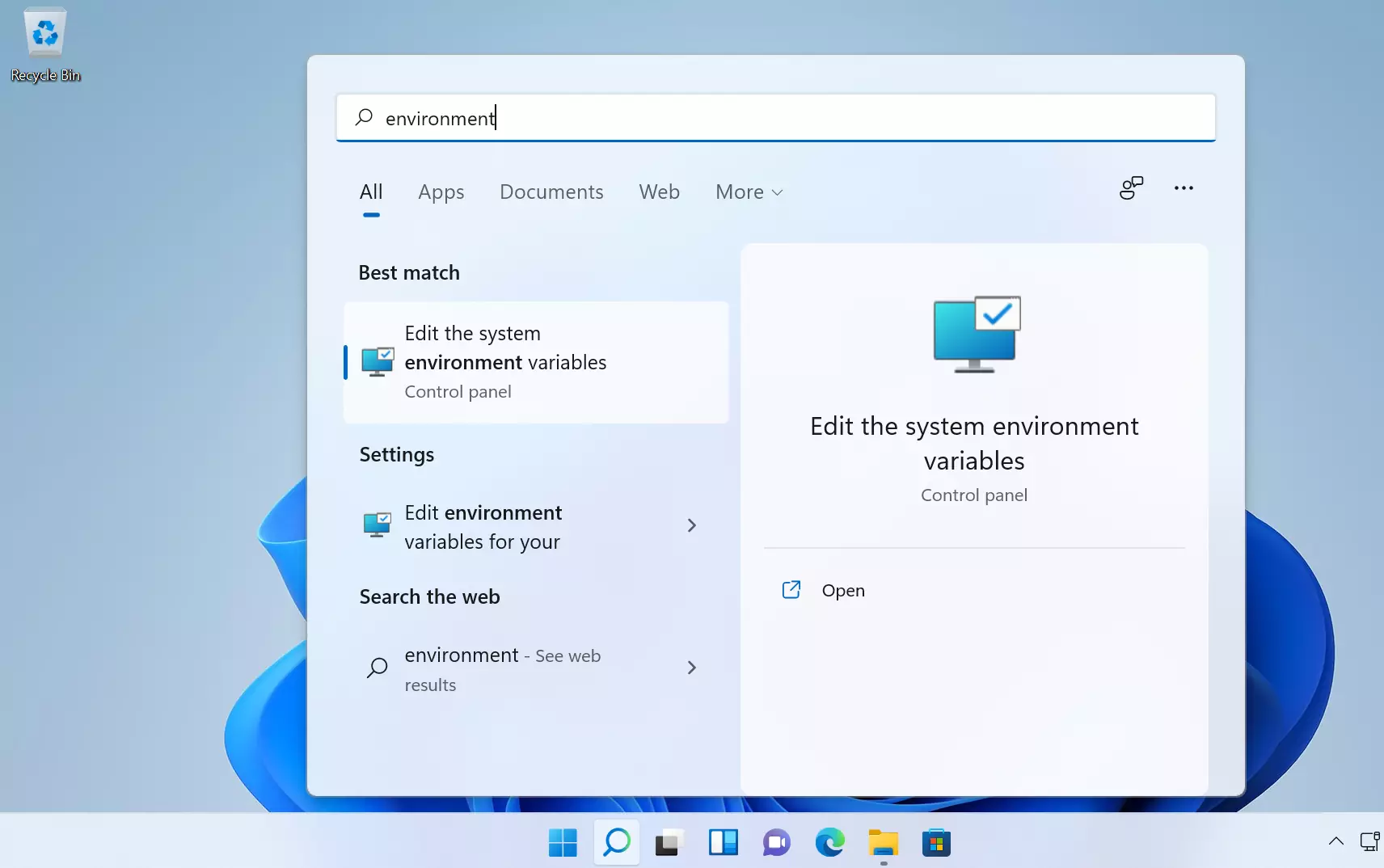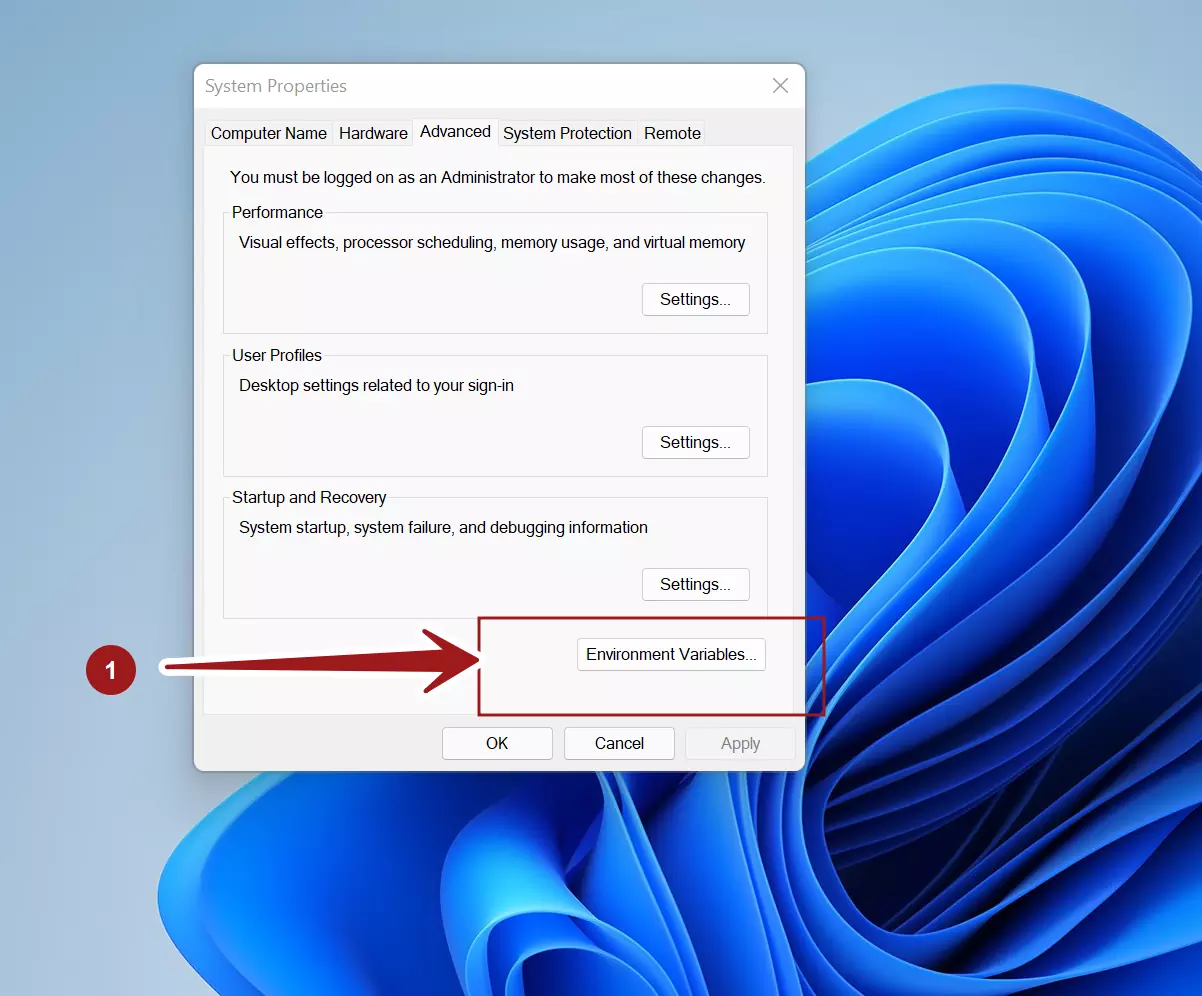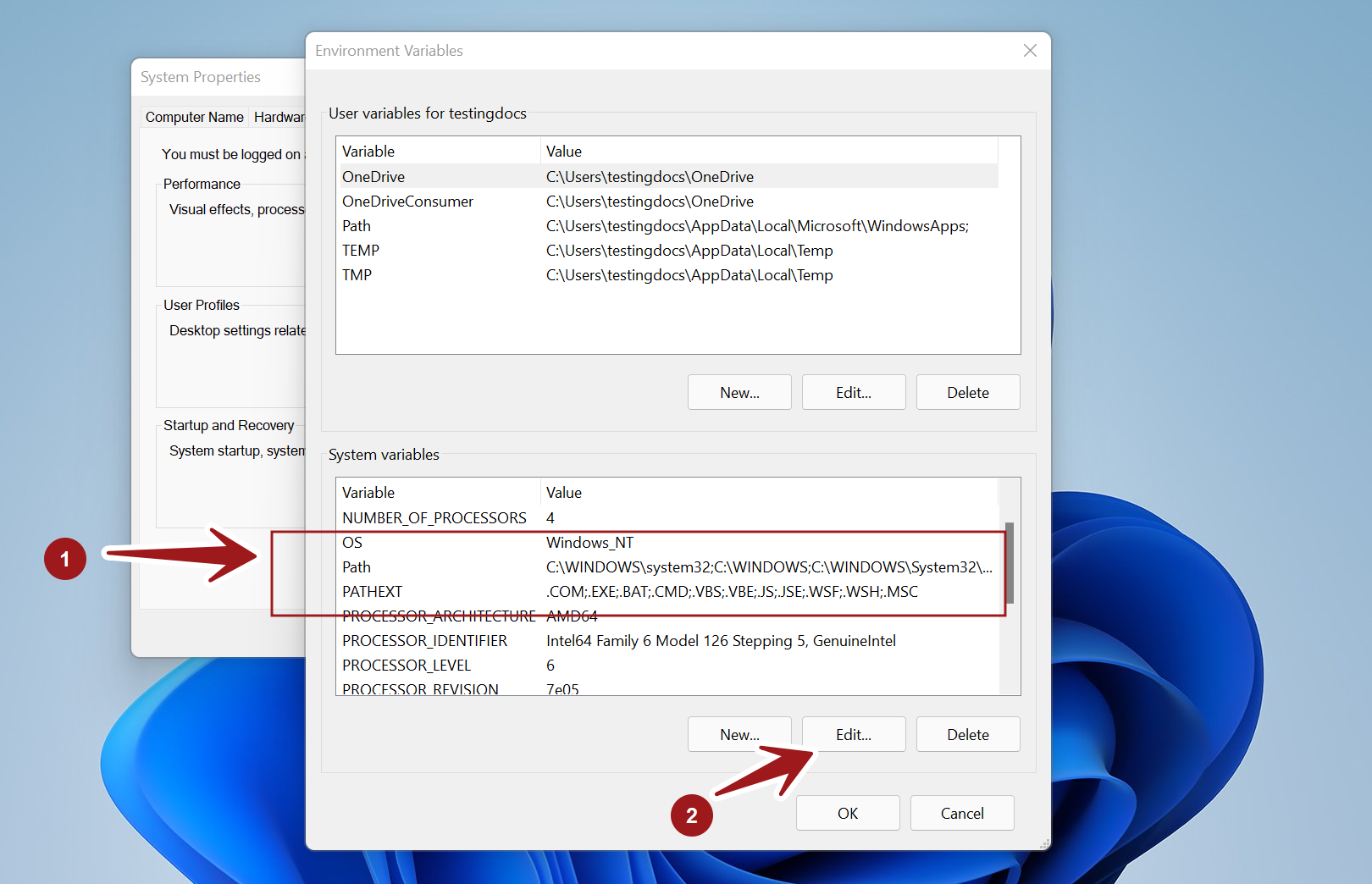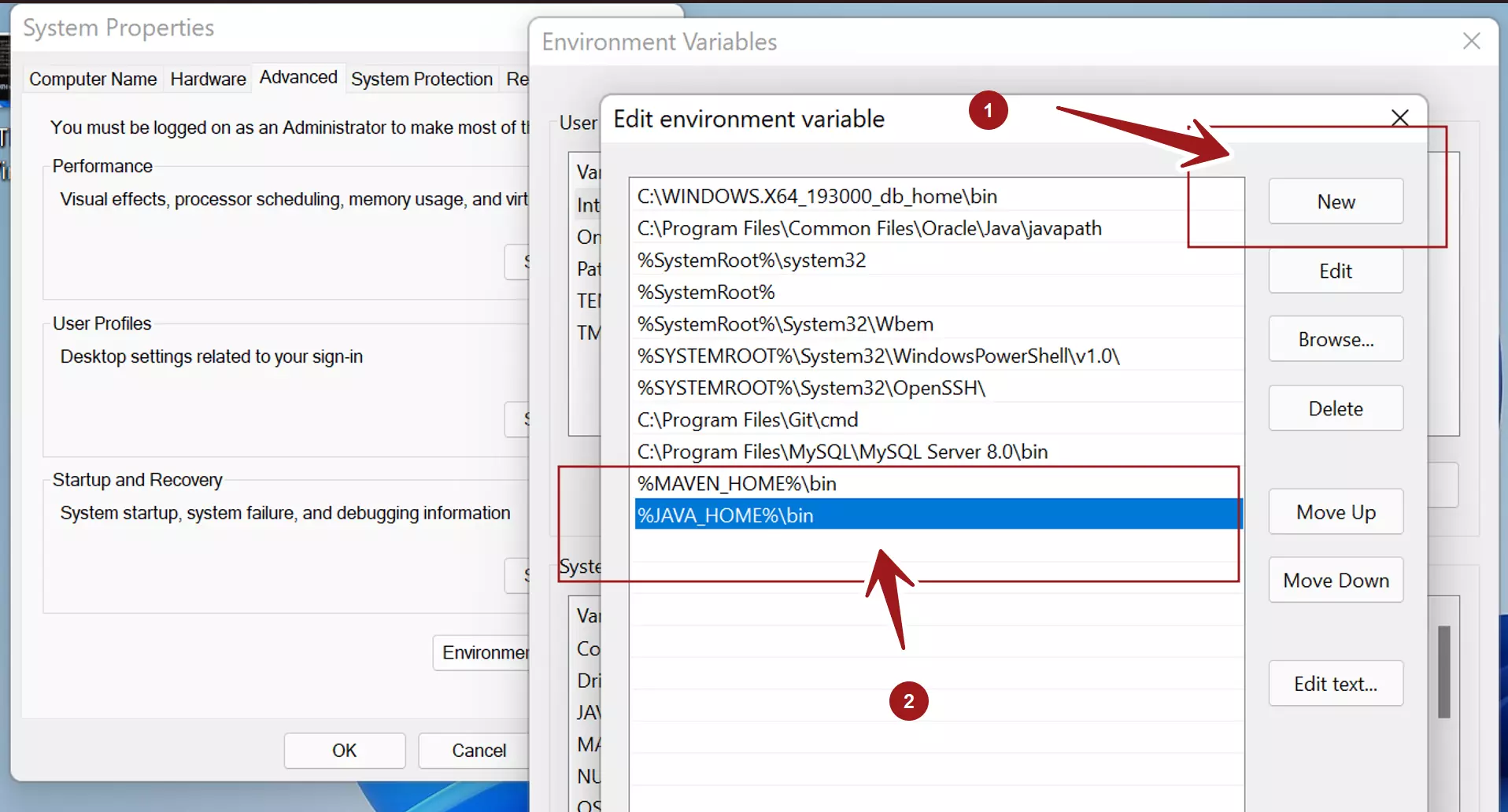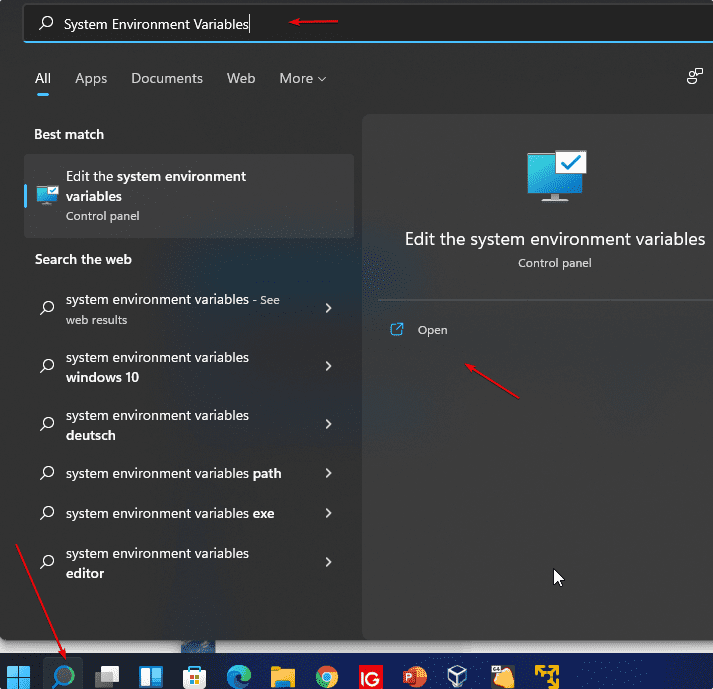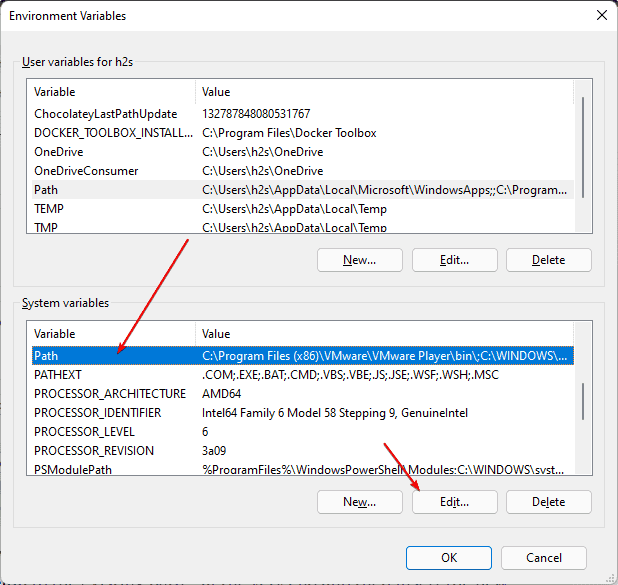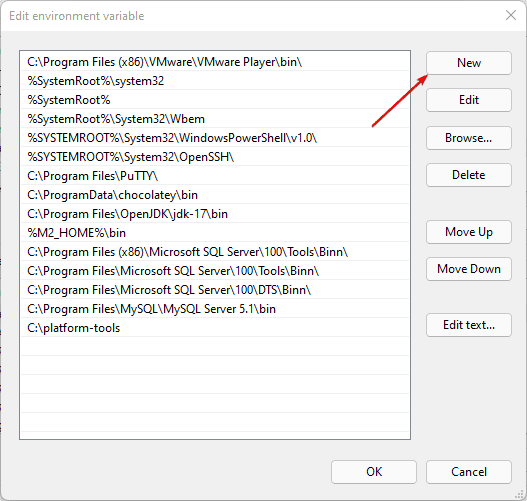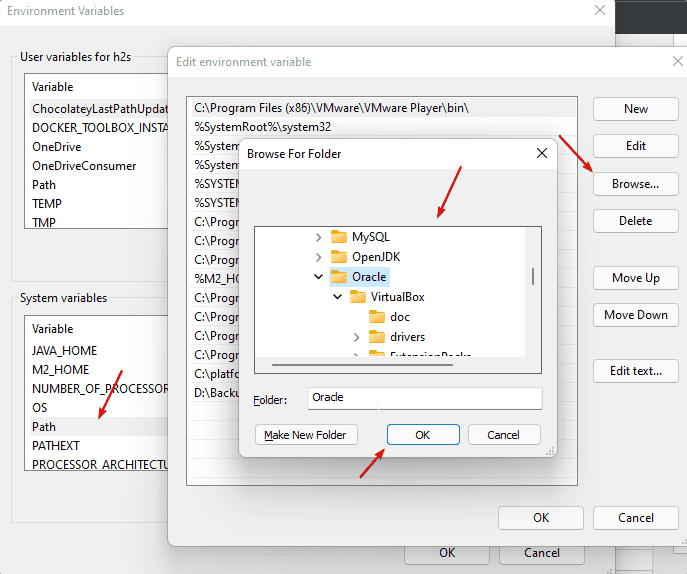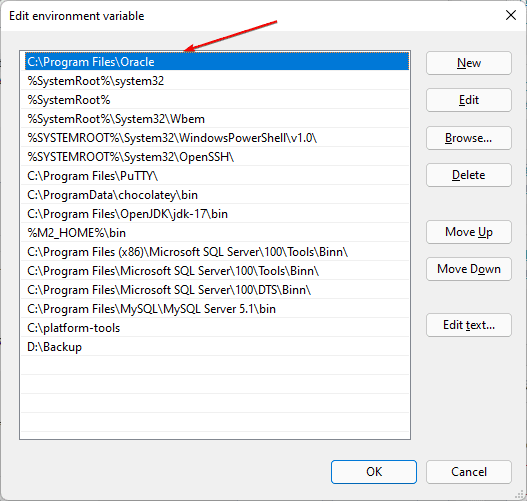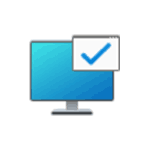
В этой пошаговой инструкции базовая информация о том, как открыть переменные среды Windows 11 и Windows 10, создать или отредактировать их.
Что такое переменные среды
Переменные среды в Windows — записи о расположении системных папок, свойствах системы и другие, которые доступны для любой программы или скрипта.
Одна из наиболее часто используемых переменных среды — PATH, указывающая на папки, в которых выполняется поиск файлов, вызываемых в командной строке, терминале Windows, файле bat или из других источников. В качестве примера её назначения:
- Если вы откроете командную строку (или диалоговое окно «Выполнить»), введёте regedit и нажмете Enter — вы сможете запустить редактор реестра, не указывая полный путь к файлу regedit.exe, поскольку путь C:\Windows добавлен в переменную среды Path.
- Если же тем же образом в командной строке написать имя программы, путь к которой не добавлен в Path (chrome.exe, adb.exe, pip и другие), вы получите сообщение «Не является внутренней или внешней командой, исполняемой программой или пакетным файлом».
Если предположить, что вы часто используете команды adb.exe (например, для установки приложений Android в Windows 11), pip install (для установки пакетов Python) или любые другие то для того, чтобы не писать каждый раз полный путь к этим файлам, имеет смысл добавить эти пути в переменные среды.
Также вы можете добавлять и иные переменные среды (не обязательно содержащие пути), а в дальнейшем получать и использовать их значения в сценариях BAT (командной строки) или PowerShell. Пример получения и отображения значения системной переменной PATH для обоих случаев:
echo %PATH% echo $Env:PATH
Получить список всех переменных среды в командной строке и PowerShell соответственно можно следующими командами:
set ls env:
Редактирование переменных среды Windows 11/10
Прежде чем приступать, учтите: изменение системных переменных среды по умолчанию может привести к проблемам в работе системы, не удаляйте уже имеющиеся переменные среды. Возможно, имеет смысл создать точку восстановления системы, если вы не уверены в своих действиях.
- Чтобы открыть переменные среды Windows вы можете использовать поиск в панели задач (начните вводить «Переменных» и откройте пункт «Изменение системных переменных среды») или нажать клавиши Win+R на клавиатуре, ввести sysdm.cpl и нажать Enter.
- На вкладке «Дополнительно» нажмите кнопку «Переменные среды…»
- В разделе «Переменные среды пользователя» (если требуется изменение только для текущего пользователя) или «Системные переменные» выберите переменную, которую нужно изменить и нажмите «Изменить» (обычно требуется именно это), либо, если необходимо создать новую переменную — нажмите кнопку «Создать». В моем примере — добавляем свои пути в системную переменную Path (выбираем эту переменную и нажимаем «Изменить»).
- Для добавления нового значения (пути) в системную переменную в следующем окне можно нажать кнопку «Создать», либо просто дважды кликнуть по первой пустой строке, затем — ввести нужный путь к папке, содержащей нужные нам исполняемые файлы.
- Также вы можете использовать кнопку «Изменить текст», в этом случае окно изменения системной переменной откроется в ином виде: имя переменной, а ниже — её значение. В случае указания путей значение будет представлять собой все пути, хранящиеся в переменной, разделенные знаком «точка с запятой».
- При создании новой переменной среды окно будет тем же, что и в 5-м шаге: необходимо будет указать имя системной переменной в верхнем поле, а её значение — в нижнем.
После создания или изменения переменной среды и сохранения сделанных настроек, переменная или обновленные значения сразу становятся доступны для текущего пользователя или в системе в целом в зависимости от того, какие именно переменные редактировались или создавались. Также есть методы добавления переменных среды в командной строке или PowerShell, подробнее в статье: Как добавить путь в переменную среды PATH
Windows
Overview
In this tutorial, we will learn the steps involved to edit the PATH variable on Windows 11 operating system. PATH is a system environment variable that Windows 11 uses to locate programs from the command line. It is a semicolon-separated string of program directories.
Check PATH variable
To check the PATH environment variable, open the command prompt.
Steps to launch command prompt on Windows 11 PC.
Type the following command.
\> echo %PATH%
Edit PATH variable
Click on the Search icon in the Taskbar.
Type Environment in the search bar.
Click on the Edit the system environment variables Control panel item.
##Alternatively, open the Run command window ( Windows Key + R ) keyboard shortcut.
Type sysdm.cpl and click on the OK button to open the System Properties window.
In the System Properties window, switch to the Advanced tab and click on the Environment Variables… button.
Select the PATH system variables and click on the Edit… button. If the PATH environment variable does not exist, click the New… button.
To edit we can change the entities listed in the window screen.
Append to PATH
To append the PATH variable, click on the New button and add the program.
For example, to append JDK bin directory by adding the following entry:
%JAVA_HOME%\bin
We can refer to other system variables with enclosing %. For example, to refer to the path of the Java home directory, we can use %JAVA_HOME%. JAVA_HOME is a system environment variable that we need to set prior to accessing it.
That’s it. We have successfully appended the JDK directory to the PATH variable.
—
Windows 11 Tutorials
More Information on Windows 11
https://www.microsoft.com/en-us/windows
Introduction
In this article, we will see how we can create and set up path environment variables in Windows 11.
Windows Environment Variables
The Environment Variable is a variable that the computer creates and maintains automatically. It assists the system in determining where to install files, locate programs, and check for user and system preferences. It may also be accessed from anywhere on the computer by graphical and command-line tools. It is required to set up the environment variables so that system knows the executable file that it needs to run on a given command.
Windows Path Variable
The PATH variable is nothing more than a directory of your computer’s applications and instructions. The PATH variable must include the address of any new program on your computer that you want to start through the command-line interface. As part of the process, Windows looks for the address for a certain command. When you send a command from the command line, Windows initially searches for it in the current directory. If it cannot be found in the current directory, the operating system checks for the address in the PATH variable.
Check Environment Variables
Use the following command to check the environment variables set on your PC.
echo %Environment Variable name%To check the Path environment variable I will use «echo %Path%»
Setup Path Environment Variable
We require permission from the system administrator and privileges to utilize and set the environment variables. As a result, you must notify the system administrator and request their assistance if you are not one.
Step 1
Open the Setting using any of the following ways
- Press Windows+R, type «sysdm.cpl» and press «Ok».
- Press Window+I
- Press Windows+X, select «System».
- Press Windows+S, search for «System».
Note
You can skip steps 1 to 3 and directly open «System Properties» by pressing Windows+S to open the search menu and typing «environment», and pressing open.
Step 2
Under System, click on «About».
Step 3
Click on «Advanced system settings».
Step 4
Click «Environment Variables…».
Step 5
The environment variables panel shows up on the screen. You can observe two types of variables
- User Variables: Use them when you wish to change the environment variables for the current or specific user.
- System Variables: Use them when you want the system-wide changes.
I want to change the path variable system-wide, hence I will double click on the highlighted row.
Step 6
Click the New button to add new paths or edit to modify the existing path. Delete will delete a path.
Press «OK» to save the changes.
If you already know the path, just write it in or copy and paste it. You may simply select Browse and then go to the route you wish to add in the System path variables.
To Create a New Environment Variable
Sometimes you may need to create a new environment variable, so for that, follow steps 1 to 4.
After that click on «New» to open the «New System Variable» popup.
Add «Variable Name», you may choose whatever name you want.
Using «Browse Directory», you can select a directory. Press OK to select the desired folder.
Using «Browse Directory», you can select a particular file. Press OK to select the desired file.
Conclusion
In this article, we discussed how we can manage path environment variables on Windows 11.
Visit C# Corner to find answers to more such questions.
Environment variables are variables that are defined in the operating system to configure certain parameters such as the path to search for a command or executable, folder for temporary files, application-specific options, etc,. There are two types of environment variables — user environment variables and system environment variables. User environment variables are specfic to each user that it is set for, while system environment variables are available to everyone on that computer.
In this article you will learn how to
- View Environment variables
- Add / Modify Environment variables
- Add / Modify / Remove PATH variable
- Manage environment variables from Advanced System Settings
View Environment Variables
The SET command is used to view environment variables from the command line. To view all environment variables,
- Open command prompt — click the search icon and type cmd in the search bar. Then click on the Command Prompt from the results.
-
On the Command Prompt, type set and press Enter.
C:\> set ALLUSERSPROFILE=C:\ProgramData CommonProgramFiles=C:\Program Files\Common Files CommonProgramFiles(x86)=C:\Program Files (x86)\Common Files CommonProgramW6432=C:\Program Files\Common Files
-
To view any specific variable, the command is
setfollowed by that variable name.C:\> set windir windir=C:\WINDOWS
Add or Modify Environment Variable
Use the setx command to add a new environment variable permanently or to modify an existing environment variable.
If you want to add or modify a environment variable temporarily to the current command window only, then the command to use is set.
setx variableName value or set variableName=value
Example
c:\> setx TESTVAR someValue SUCCESS: Specified value was saved.
Now, open a new command prompt and run the set command to verify that the new environment variable is created.
c:\> Set testvar TESTVAR=someValue
Adding System Environment Variables
By default, the setx command adds the variables as user variable in the local environment. To add a variable to the system environment use the /m parameter. You also need run the command prompt as an administrator.
c:\> setx TESTVAR someValue /m SUCCESS: Specified value was saved.
If the command windows is not run in administrator mode then you will get the following error
ERROR: Access to the registry path is denied.
The variables in the system environment are available to all users of the computer.
Difference between SET and SETX
The SET command is used to view, create and modify environment variables temporarily for the current command window. The variable that you add using SET are not available on any future command windows.
SETX command adds the variables permanently. The variables that are added using SETX are not available on the current command window but will be available on all future windows.
You cannot use setx to remove a environment variable but you can use set to remove a variable from the current command window.
Setting PATH variable
The PATH variable defines the search path for executable files. You can set the PATH variable from the command line or GUI.
View current PATH
To view the current path you can simply run the path command or echo %PATH% command.
c:\> path PATH=C:\windows\system32;C:\windows;C:\windows\System32\Wbem;C:\windows\System32\WindowsPowerShell\v1.0\;C:\Program Files\Intel\Intel(R) Management Engine Components\DAL;C:\WINDOWS\system32;C:\WINDOWS;C:\WINDOWS\System32\Wbem;C:\WINDOWS\System32\WindowsPowerShell\v1.0\;C:\WINDOWS\System32\OpenSSH\;
Add path to current PATH
To add new path to the exiting path, use the SET or SETX command.
For example, to add the directory c:\NewFolder to existing path, the command is
c:\> set PATH=c:\NewFolder;%PATH%
Modify an existing path
The SET and SETX commands can be also used to modify an existing path. The syntax for this command is
set PATH=%PATH:current_path=new_path%
For example, to change c:\NewFolder in the current path to c:\AnotherFolder, the command is
set PATH=%PATH:c:\NewFolder;=c:\AnotherFolder;%
Remove path from current PATH
The syntax for removing a folder path from the current PATH is same as modifying an existing path explained above, except that you just have to omit the new path.
set PATH=%PATH:path_to_remove;=%
For example, to remove c:\AnotherFolder; from the existing path, the command is
set PATH=%PATH:c:\AnotherFolder;=%
Manage Environment variables from Advanced System Settings
You could also manage environment variables from Advanced System Settings in Windows. Type env in the search box and select Edit environment variables for your account. This will open Environment Settings dialog from where you can add, edit and delete system and user environment variables.
In Windows 11, the environment variables (env) can be easily set via the graphical user interface. The ENV on Windows or other operating-system needed by it to let it know exactly where the most important files are stored. And that can be a little different on every computer. For most Windows users, the system is located in the C:\Windows\ folder and programs in the C:\Program Files\folder. But it is not always the case.
And this is the reason why the paths are important locations, they are not permanently programmed, but are stored in so-called environment variables.
There are also environment variables that do not lead to any folders. These are variables like Dirverdata, PATHEXT, and more…
Environment variables are an important element of every operating system, including Windows 11. But how do you actually get them?
Add or Display system variables Path in Windows 11
1. Open Edit system environment variables
For this, you simply use the Windows 11 search and search for “Edit system environment variables“. Then simply select the result and the following window with the system properties will open.
2. System Properties
You will see the “System Properties” there click on the “Environment Variables …” button, which is already focused on in the given screenshot.
3. Add System Variables or User Variable on Windows 11
On the Environment Variable windows you will have two choices:
- User variables for your account; the folder path added under it will only be accessible by that particular user
- System variables for the entire operating system, hence any user account will be able to access the executables or folder declared under it.
Added System variables are visible to all user accounts. If it is the case that only you use the PC, it is sufficient to set user variables. However, here we are going for “System Variables“. You can choose between as per your choice.
Select the Path and hit the Edit button.
4. Create a New Variable and add the path in Windows 11
As you click the Edit button in the above step, the corresponding window will open. After that add the path of the folder or executable that you want to add.
Alternatively, we can also browse the same.
For example, to integrate the Oracle VirtualBox, simply edit the “Path” variable under the system or user variables. So follow the below steps…
• Select the Path variable, click on Edit … and click on Browse
• A file explorer tree will open, go to the folder that you want to add, and hit the OK button.
Then confirm all windows with OK and restart the command line (Windows Terminal/PowerShell/Command Prompt) and start accessing your executable directly in it once. The old variables are still saved in the open instance.
In this way, we can add any path to our system on Windows 11 using the graphical user interface. the user can also remove any of the added paths in a similar way.
